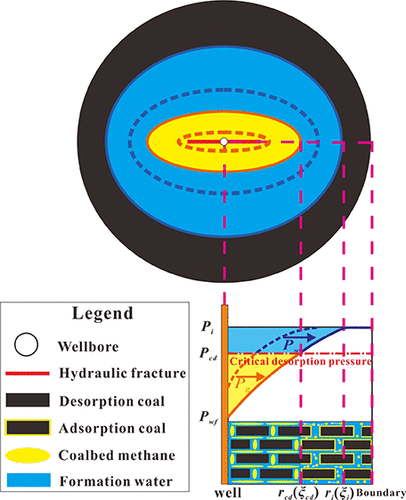当前位置:
X-MOL 学术
›
Energy Fuels
›
论文详情
Our official English website, www.x-mol.net, welcomes your feedback! (Note: you will need to create a separate account there.)
A Prediction Model for Pressure Propagation and Production Boundary during Coalbed Methane Development
Energy & Fuels ( IF 5.3 ) Pub Date : 2021-01-11 , DOI: 10.1021/acs.energyfuels.0c03354 Xinlu Yan 1, 2, 3 , Songhang Zhang 1, 2, 3 , Shuheng Tang 1, 2, 3 , Zhongcheng Li 4 , Wei Guan 5 , Qian Zhang 1, 2, 3 , Jingyu Wang 1, 2, 3
Energy & Fuels ( IF 5.3 ) Pub Date : 2021-01-11 , DOI: 10.1021/acs.energyfuels.0c03354 Xinlu Yan 1, 2, 3 , Songhang Zhang 1, 2, 3 , Shuheng Tang 1, 2, 3 , Zhongcheng Li 4 , Wei Guan 5 , Qian Zhang 1, 2, 3 , Jingyu Wang 1, 2, 3
Affiliation

|
In coalbed methane field development, an accurate understanding of dynamic propagation of reservoir pressure is crucial for predicting production potential, enhancing recovery, and engineering planning. Based on actual reservoir conditions and production data, a semi-analytical mathematical model that considers the self-regulating effects of coal reservoirs was established for both nonstimulated and hydraulically fractured vertical wells in undersaturated coal reservoirs. In the model, undersaturated coal seam is divided into the drainage area and desorption area. Material balance equations (MBE) are deduced based on the unique gas–water production mechanism of coal seams, and pressure profiles are expressed as continuous succession of steady state flow. The pressure propagation can be finally predicted by combining MBE and pressure profiles in different areas. Three hydraulically fractured vertical wells with different production characteristics in the Shizhuangnan Block, southern of Qinshui Basin are taken as examples to verify the applicability of the model. Results show that dynamic pressure propagation of a single well is accurately characterized in the early production stage, and the shape of the pressure propagation area translates from an ellipse into a circle during production; actual interference boundaries or damage boundaries are precisely predicted when interwell pressure interference is formed or a poor production strategy is adopted, respectively. Additionally, mechanism analysis under a mathematic model and orthogonal experiment evaluation are adopted to quantify the sensitivity of various parameters on the prediction results. Results show that coal reservoir physical properties, especially critical desorption pressure and porosity, mainly affect drainage radius expansion, whereas human factors and adsorption performance are the key factors influencing the desorption radius. The proposed model develops an accurate and efficient mathematical method for evaluating dynamic characteristics of pressure propagation in undersaturated coal reservoir and predicting production boundary and finally provides valuable guidance for the formulation of reasonable development plans.
中文翻译:

煤层气开发过程中压力传播和生产边界的预测模型
在煤层气田开发中,对储层压力动态传播的准确理解对于预测生产潜力,提高采收率和工程规划至关重要。根据实际油藏条件和生产数据,建立了一个半解析数学模型,该模型考虑了欠饱和煤层中非增产和水力压裂垂直井的煤层自调节作用。在该模型中,将不饱和煤层分为排水区和解吸区。根据煤层独特的气水产生机理推导了物料平衡方程(MBE),压力曲线表示为稳态流的连续连续性。通过组合MBE和不同区域的压力曲线,最终可以预测压力传播。以沁水盆地南部石庄南区块三口不同生产特征的水力压裂垂直井为例,验证了该模型的适用性。结果表明,单井动态压力传播在生产初期得到了准确表征,压力传播区域的形状在生产过程中从椭圆形变为圆形。当形成井间压力干扰或采用不良的生产策略时,可以分别准确预测实际的干扰边界或破坏边界。另外,通过数学模型的机理分析和正交实验评估,量化了各种参数对预测结果的敏感性。结果表明,煤层气藏的物理性质,特别是临界解吸压力和孔隙度,主要影响排泄半径的扩大,而人为因素和吸附性能是影响解吸半径的关键因素。该模型为评估欠饱和煤层压力传播的动态特征和预测生产边界提供了一种准确而有效的数学方法,并为制定合理的开发计划提供了有价值的指导。尤其是临界解吸压力和孔隙度,主要影响排水半径的扩大,而人为因素和吸附性能是影响解吸半径的关键因素。该模型为评估欠饱和煤层压力传播的动态特征和预测生产边界提供了一种准确而有效的数学方法,并为制定合理的开发计划提供了有价值的指导。尤其是临界解吸压力和孔隙度,主要影响排水半径的扩大,而人为因素和吸附性能是影响解吸半径的关键因素。该模型为评估欠饱和煤层压力传播的动态特征和预测生产边界提供了一种准确而有效的数学方法,并为制定合理的开发计划提供了有价值的指导。
更新日期:2021-01-21
中文翻译:

煤层气开发过程中压力传播和生产边界的预测模型
在煤层气田开发中,对储层压力动态传播的准确理解对于预测生产潜力,提高采收率和工程规划至关重要。根据实际油藏条件和生产数据,建立了一个半解析数学模型,该模型考虑了欠饱和煤层中非增产和水力压裂垂直井的煤层自调节作用。在该模型中,将不饱和煤层分为排水区和解吸区。根据煤层独特的气水产生机理推导了物料平衡方程(MBE),压力曲线表示为稳态流的连续连续性。通过组合MBE和不同区域的压力曲线,最终可以预测压力传播。以沁水盆地南部石庄南区块三口不同生产特征的水力压裂垂直井为例,验证了该模型的适用性。结果表明,单井动态压力传播在生产初期得到了准确表征,压力传播区域的形状在生产过程中从椭圆形变为圆形。当形成井间压力干扰或采用不良的生产策略时,可以分别准确预测实际的干扰边界或破坏边界。另外,通过数学模型的机理分析和正交实验评估,量化了各种参数对预测结果的敏感性。结果表明,煤层气藏的物理性质,特别是临界解吸压力和孔隙度,主要影响排泄半径的扩大,而人为因素和吸附性能是影响解吸半径的关键因素。该模型为评估欠饱和煤层压力传播的动态特征和预测生产边界提供了一种准确而有效的数学方法,并为制定合理的开发计划提供了有价值的指导。尤其是临界解吸压力和孔隙度,主要影响排水半径的扩大,而人为因素和吸附性能是影响解吸半径的关键因素。该模型为评估欠饱和煤层压力传播的动态特征和预测生产边界提供了一种准确而有效的数学方法,并为制定合理的开发计划提供了有价值的指导。尤其是临界解吸压力和孔隙度,主要影响排水半径的扩大,而人为因素和吸附性能是影响解吸半径的关键因素。该模型为评估欠饱和煤层压力传播的动态特征和预测生产边界提供了一种准确而有效的数学方法,并为制定合理的开发计划提供了有价值的指导。



























 京公网安备 11010802027423号
京公网安备 11010802027423号